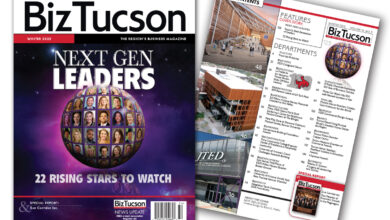
No. 1 UNESCO City of Gastronomy
Desert’s Culinary Scene Reigns Supreme
11 REASONS THE WORLD IS WATCHING TUCSON
By June C. Hussey
What does Tucson have in common with Bergamo, Italy; Bendigo, Australia; and Phuket, Thailand? The correct answer is: All are UNESCO-designated Cities of Gastronomy.
So what’s the big deal?
According to VisitTucson.com, travel is the leading export-oriented industry in Arizona and according to the World Food Travel Association, visitors spend approximately 25% of their travel budget on food and beverages. Cities of Gastronomy benefit from increased global media exposure and tourism. And after two tumultuous years of the COVID-19 pandemic, tourism and business travel are rebounding with a vengeance.
So when Food & Wine’s Travel Issue in May said Tucson is one of the “next great food cities” and BuzzFeed blogger AnaMaria Glavan described Tucson as “a city of detailed murals, quaint shops, morgues-turned-bars, and oh yeah, it’s also a UNESCO City of Gastronomy due to its high volume of amazing food,” in a 2021 travel column, the acclaim only reaffirmed this region’s prowess in cuisine.
After all, it’s no secret that the James Beard Awards – the Academy Awards of foodies – have consistently honored numerous Tucson chefs including Janos Wilder, who enjoyed a storied culinary career here, and El Guero Canelo’s Daniel Contreras. Award finalists currently include Don Guerra of Barrio Bread and semifinalists have included Carlotta Flores’ El Charro Café, Maria Mazon of Boca Tacos y Tequila and John Martinez of Tito & Pep.
In late 2015, UNESCO designated Tucson a City of Gastronomy – the first of only two in the country. A group of conscientious Tucson leaders had strategically applied for the UNESCO designation, presenting an impressive case: As the country’s oldest continuously inhabited and cultivated region, Tucson’s noteworthy gastronomical heritage has been in the making for 4,000 years. Two-thirds of Tucson’s 1,200+ restaurants and bars are locally owned, compared to the national average of 40% and Tucson has 12 times the number of locally owned food trucks and carts per capita than New York City. All of these factors combined make Tucson a gastronomy dream town.
Only three dozen cities in the world hold the prestigious designation, which comes up for renewal every four years. To qualify, a city must demonstrate that it possesses all of the following characteristics:
- Well-developed gastronomy that is characteristic of the urban center and/or region;
- Vibrant gastronomy community with numerous traditional restaurants and/or chefs;
- Indigenous ingredients used in traditional cooking;
- Local know-how, traditional culinary practices and methods of cooking that have survived industrial/technological advancement;
- Traditional food markets and traditional food industry;
- Tradition of hosting gastronomic festivals, awards,
- contests and other broadly targeted means of recognition;
- Respect for the environment and promotion of sustainable local products;
- Nurturing of public appreciation, promotion of nutrition in educational institutions and inclusion of biodiversity conservation programs in cooking schools curricula.
A nonprofit board comprising key stakeholders helps ensure that Tucson maintains its status in the eyes of UNESCO. Tucson City of Gastronomy is a 501(c)(3) organization whose mission is “growing a sustainable desert community by supporting our creative food cultures.” Tucson is also a member of the Delice Network, a professional network linking food and gastronomy to city development, promotion and the overall well-being of its citizens.
Two consecutive spring festivals are also popularizing the area’s ancient and new world cultural traditions. The agave plant, synonymous with the borderlands region, is the source of tequila, mezcal and bacanora. The Agave Heritage Festival, held the last weekend in April, draws attention to the cultural and commercial significance of the ubiquitous desert plant, with increasing focus on sustainable spirit production. Recognizing that tequila and tacos go hand in hand, Visit Tucson wisely brought the Pueblos del Maiz Fiesta into being the first week of May. Now, after the area’s long history and culture of maize cultivation, this bilingual culinary festival is putting Tucson squarely on the map.
Not a month goes by that there isn’t something food-worthy to celebrate in Tucson and all of Tucson’s food-forward festivals owe a deep bow of respect to Tucson Meet Yourself, the mother of them all.
Sponsored by the Southwest Folklore Alliance and the University of Arizona’s Southwest Center along with dozens of local businesses, this free event has been attracting attention to downtown Tucson on the second weekend in October since 1974. Because of Tucson Meet Yourself, more than 100,000 people come together every fall to experience a funky mixture of food, folk art and performances.
Tucson Meet Yourself was co-founded by University of Arizona folklorist and anthropologist James Griffith, together with his wife, Loma. They understood early on, perhaps better than anyone, why this melting pot of indigenous, European and many other cultures is worth preserving and celebrating.
When Griffith passed away late last year, Gary Nabhan, co-founder of Native Seeds/Search and TCoG board member was quoted in the Tucson Sentinel: “None of us who were involved in forwarding Tucson as a UNESCO City of Gastronomy in 2015 could have achieved that designation without the groundwork that Big Jim had developed though years of food folklore celebrations.”





